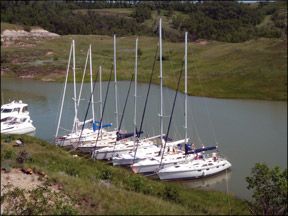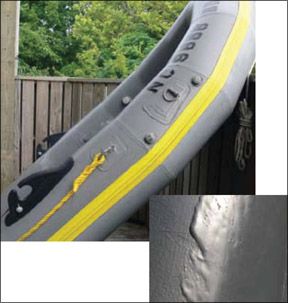I sail a 2009 Hunter H33. This is our second season on her. We sail a big inland lake in North Dakota and do a lot of “shoring up” for the night—it is common here—and I’d like to see a comparison of shore anchors. We usually tie off to large shoreside stakes. Stake the nose, and then fore and aft tie each boat. Some guys use a screw stake, but most use the “Shore Anchor” brand. Been through some ugly storms this way!
Richard J. Northrup
A Little Nauti, Hunter H33
North Dakota

Photo courtesy of Richard J. Northrup
288
Shore tying for the day is common in many cruising areas, but usually the boat is secured to a fixed object like a tree or a boulder. As for anchoring, what works in the water will work in sand or mud on shore, so long as the anchor is well set and the angle of pull is correct. Long stakes will work for short stops, but they offer marginal security in a blow. A better option would be a screw with a proper lever to drive it in. Whatever method you choose, recognize that being close to shore can brings additional risks.
We haven’t tested the Shore Anchor, but it would be interesting to see how it and other land anchors stand up to the marine anchors in our testing stable. Fortress and Bruce (February and October 2006) make some good lightweight anchors for soft sand and mud that you could dinghy ashore. A good Danforth would be fine for most spots with sand or parked mud, as would a Lewmar Claw (February 2006).
Two online resources worth checking out would be our “Choosing Ground Tackle for Cruising” (www.practical-sailor.com/tools/sailboat_anchor_selection.html) and a recent Q&A blog post by adventure cruisers John Harries and Phyllis Nickel on shorefast systems (www.morganscloud.com).
I believe you should have given the Cobra HH475 VHF handheld radio (June 2010) a conditional approval: Any VHF radio used offshore (or on a very large lake or river) should be equipped with an antenna that can be disconnected so that the handheld can be connected to the ship’s antenna in case the main VHF radio fails.
On my sailboat, I have a UHF female-to-BNC male adaptor so I can use my Uniden with the masthead antenna. When we were on the Chesapeake Bay, I could raise Baltimore Marine operator using only 1 watt TPO from the Delaware River. If I had had a handheld radio back then, I could have made phone calls with it as well. Instead, I had CB and 2-meter Ham radios on board—all with masthead antennas.
Gordon Allison
Compac 23/II
Lake Granby, Colo.
I built this ketch (below) from a Reuel Parker design and used Practical Sailor for working my way through a lot of equipment and “how-to” questions.
Albert Butkas
Via e-mail

Photo courtesy of Richard J. Northrup
288
In regards to the “Soapless in Seattle” letter in the June 2010 issue [regarding a marina ban on using soaps for boat cleaning]: Try Basic H2! The letter’s author should get a bottle of Basic H2 Organic Super Cleaning Concentrate, the original Earth Day cleanser made by Shaklee (www.shaklee.com). It’s a surfactant, so it contains no soap or detergent. It will clean your boat, dishes, dog, teak, and it’s great in the shower! It will not harm a living thing and is also a good, odorless mosquito repellent. (Just think of all the bottles you can toss!) P.S.: Seattle will love it.
Lloyd Duncan
S/V Maya
Oxford, Md.
We ordered a bottle of the Basic H2 from Shaklee and will be testing it against marine cleaners in future issues.
I sail my Cal 29 on Puget Sound. My boat can be competitive in our club’s PHRF racing, but only with a low-drag propeller. I have read your magazine for many years, but I do not recall a review of low-drag propellers, something almost every sailor could use who has an inboard auxiliary. The number of types and features has me a little confused, and I wish to find the best feathering propeller for my 20-horsepower Perkins Perama inboard diesel. Please consider a review of folding and feathering propellers.
Mel Chandler
Carol Jean, Cal 29
Edmonds, Wash.
We haven’t held a head-to-head test of props since the mid-90s, but those tests and reports offer some great information on the type of performance you can expect from different style props, including two-bladed and three-bladed feathering props. Test products included props from Michigan Wheel, Campbell Sailer, Martec, Autoprop, and Max-Prop. The in-depth tests were conducted at the Massachusetts Institute of Technology and were reported on in the Oct. 1, 1993 and Jan. 1, 1995 issues.
When selecting the best prop for your boat, determining the correct diameter and pitch is 98 percent of the battle. Other important factors to consider are what type of sailing you do, where you keep the boat, etc.
In the MIT tests, we found that as far as feathering/folding props, Martec and Gori had high efficiency ratings but lackluster performance in reverse, and the Gori was quite pricey. Max-Props feathering props had low drag and good reverse performance but not great efficiency in forward. Max-Props is frequently cited by readers for their good customer support.
I’d like to offer some feedback on articles in the June edition of PS. Regarding the comparison of coconut water sports drinks: The cons against sport drinks should also include sodium and caffeine, both of which are not good for you. If a person is following a proper diet, the other additives—like vitamins—are not necessary and, in some cases can be bad for you. Note also that sugar is sugar, whether it is called “natural” or not (high-fructose corn syrup could be called “natural”) and should be limited in one’s diet.
I find that just plain water works for me and, from a good source, really does taste good. My tap does just fine and, if zip is desired, I add a bit of lemon and seltzer.
Your article on woodenboat building, “Father and Son 101,” was great article, but in addition to Chesapeake Light Craft and Adirondack Guide Boat Co., you should have mentioned some of the many other companies that have small boat plans and kits, including Newfound Woodworks Inc. (www.newfound.com), Pygmy Boats (www.pygmyboats.com), Bear Mountain Boats (www.bearmountainboats.com), and Redfish Kayak and Canoe Co. (www.redfishkayak.com).
Jim Keene
Seal Cove, Maine
Your article on staying hydrated (June 2010) is very important; however, the author left out the simplest method of monitoring your state of hydration: Checking the color of your urine.
If your urine is dark, increase your fluid intake. If your output is low, increase it substantially. If your urine is a very pale yellow, you are probably OK. It is more complicated, but that is a good starting point.
Harvey J. Karten, M.D.
La Jolla, Calif.
I just read “Tender Lovin’ for Aging Dinks” (June 2010) and wanted to respond with a personal experience. I was about to toss my 1984 vintage 9-foot Avon dinghy, since it had been lying deflated in my garage for several years. However, with a little time on my hands last fall, I repaired and painted the floor boards and transom, and talked with the helpful folks at Inland Marine.
The Avon had a long history of high-speed sandy beaching, and the usual accidental encounters with rocks, coral, barnacles, and pilings, and had even survived a trip to Abacos and back to Beaufort Inlet, S.C., tucked in and rolled up behind the backstay of my Cape Dory 31.
Needless to say, when I began the project, she was thin skinned, bubbled from numerous pores when inflated, and leaked like the proverbial sieve. Encouraged by Inland Marine’s advice, and for the usual sentimental reasons, I rolled up my sleeves. First, washing her down with laundry detergent until she was squeaky clean and then with acetone as directed. We applied the IM Liquid Rubber, and let it cure for the prescribed week, at which time, it looked brand new. One coat of IM Topside paint was icing on the cake, and after another week, she was launched as amazed son-in-laws and skeptical friends and neighbors admired the reincarnation!
I have had zero adhesion problems, and would recommend Inland Marine to anyone without reservation. All you need is two Saturdays, a little patience, and you are virtually guaranteed that you will have a very satisfactory result. And the related good memories do not fade!
Lin Church
Cape Dory 31
Beaufort, S.C.

Photo courtesy of Richard J. Northrup
288

288
We recently got back to the USA after 1.5 years cruising Caribbean ports from the Bahamas through Venezuela & the ABCs. In Fort Lauderdale, we waited over a week for an iPad 3G model with AT&T connectivity and 64 GB of memory. We will use it for backup navigation and planning, and will use its Skype while on phone exile and cruising the U.S. East Coast and crossing the Atlantic.
We love it! It and iNavX are a complete solution for navigation, especially with the charts from Fugawi on it. Take a look at www.macenc.com for more info on iNavX. (We bought and have used MacENC on a Mac based on your review and have never regretted it—from Maine through Margarita island!)
Now in the midst of three weeks down from a $16,000 lightning strike, we are using both MacENC and the iPad while we wait for a new chartplotter installation. (We are writing this from our bunk on the iPad as a matter of fact.) I’d recommend it highly.
Ed Kelly
Angel Louise,
Catalac 12 Meter
Brunswick Landing Marina, Ga.

































